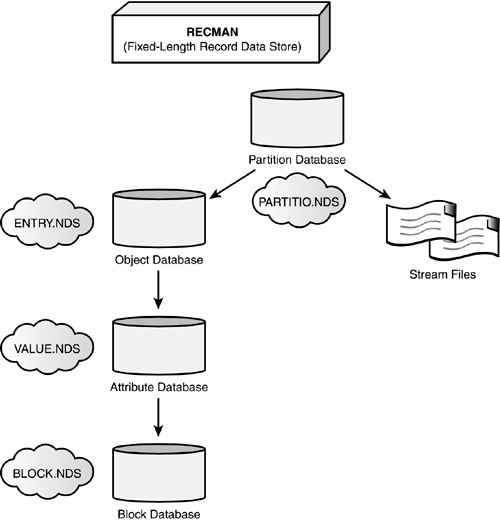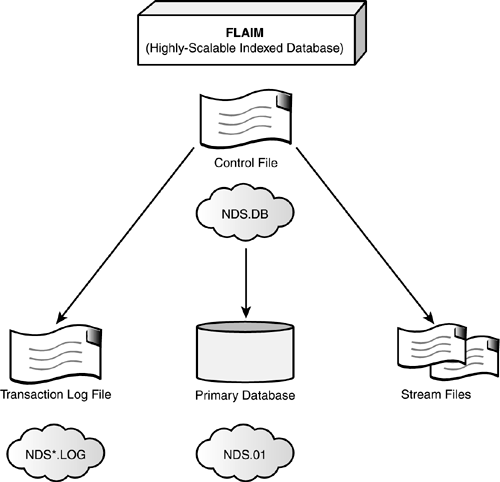Understanding eDirectory 8.6
| Test Objective Covered:
eDirectory 8.6 is a highly scalable, high-performing, secure directory service. Along with replication and partitioning capabilities, eDirectory provides the basic foundation for multiplatform networking. eDirectory also includes cryptography services to protect confidential data; it natively supports LDAP 3 over SSL (Secure Socket Layer). Earlier versions of eDirectory were called Novell Directory Services (NDS). At first glance, eDirectory appears to have the same underlying architecture as NDS. That is, a distributed, object-oriented database organized as a hierarchical tree. Upon closer inspection, however, you'll find that eDirectory 8.6 is built on a much more sophisticated database structure than NDS. Let's take a closer look at the underlying architectural differences between NDS and eDirectory, starting with NDS. NDS ArchitectureNDS was first introduced in NetWare 4. Prior to NetWare 4, NetWare operating systems relied on a server-centric model in which each NetWare server had its own flat-file database for tracking network resources (called the bindery). The bindery consisted of three files: one that held object, one that held property, and one that held value information. NDS offered a gigantic leap forward by evolving the server-centric model into a network-centric model. In this architecture (shown in Figure 3.1), the NetWare 4 operating system relies on four data files and multiple streams files located in a hidden directory on the server's SYS: volume. This database is referred to as the RECMAN database. Figure 3.1. NDS architecture.
The four files that make up the NDS architecture in Figure 3.1 perform these functions:
NDS streams files are named with hexadecimal characters (0-9, A-F) and hold information such as print job configurations and login scripts. Earlier versions of NDS used Novell's Transactional Tracking System (TTS) to ensure that database transactions were either completed or backed out in the event of a system failure. TIP The NetWare 5 version of NDS uses the same architecture as described above; however, the names of the files are different. In NetWare 5, ENTRY.NDS is called 0.DSD, VALUE.NDS is called 1.DSD, BLOCK.NDS is called 2.DSD, and PARTITIO.NDS is called 3.DSD. eDirectory 8.6 ArchitectureeDirectory 8.6 improves on NDS' fixed-length record data store model by introducing a highly scalable indexed database called FLAIM (FLexible and Adaptable Information Manager). The FLAIM database uses three different types of files instead of four, but still relies on streams files for print job configurations and login scripts. Check out the eDirectory 8.6 architecture in Figure 3.2. Figure 3.2. eDirectory 8.6 architecture.
Following is a description of each of the three different types of files that make up eDirectory's FLAIM database:
eDirectory streams files perform the same function as they do in NDS and have an .NDS extension. However, unlike NDS, eDirectory does not use TTS; instead, it uses log files to back out and roll forward transactions in the event of a system failure. Refer to Table 3.1 for a summary of the differences between NDS and eDirectory architecture. TIP The primary eDirectory database file, NDS.01, includes a number of indexes to enhance performance. First, it includes attribute substring indexes for the "CN" and "uniqueID" fields. Second, it includes attribute indexes for the "Object Class" and "dc" fields. Finally, it includes attribute indexes for positioning that include strings beginning with CN, uniqueID, Given Name, and Surname.
The eDirectory architecture described here provides an exceptional foundation for all of eDirectory 8.6's new features and benefits. Following is a brief list of some of eDirectory's greatest new advancements:
This completes our architectural lesson of eDirectory 8.6. We hope that you have gained an appreciation for the sophisticated directory services platform that eDirectory 8.6 provides for your NetWare 6 network. Now that you understand how it's built, you're ready to learn how to integrate it into your existing network. |
EAN: 2147483647
Pages: 128

